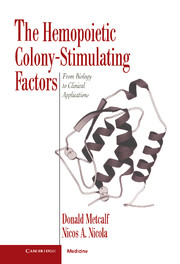Book contents
- Frontmatter
- Contents
- Preface
- 1 Historical introduction
- 2 General introduction to hemopoiesis
- 3 Key techniques in analyzing hemopoiesis
- 4 Biochemistry of the colony-stimulating factors
- 5 Biochemistry of the colony-stimulating factor receptors
- 6 Molecular genetics of the colony-stimulating factors and their receptors
- 7 Biological actions of the colony-stimulating factors in vitro
- 8 The biology of colony-stimulating factor production, degradation, and clearance
- 9 Actions of the colony-stimulating factors in vivo
- 10 Role of the colony-stimulating factors in basal hemopoiesis
- 11 Actions of the colony-stimulating factors in resistance to infections
- 12 Role of the colony-stimulating factors in other disease states
- 13 The colony-stimulating factors and myeloid leukemia
- 14 Clinical uses of the colony-stimulating factors
- 15 Conclusions
- References
- Index
12 - Role of the colony-stimulating factors in other disease states
Published online by Cambridge University Press: 04 August 2010
- Frontmatter
- Contents
- Preface
- 1 Historical introduction
- 2 General introduction to hemopoiesis
- 3 Key techniques in analyzing hemopoiesis
- 4 Biochemistry of the colony-stimulating factors
- 5 Biochemistry of the colony-stimulating factor receptors
- 6 Molecular genetics of the colony-stimulating factors and their receptors
- 7 Biological actions of the colony-stimulating factors in vitro
- 8 The biology of colony-stimulating factor production, degradation, and clearance
- 9 Actions of the colony-stimulating factors in vivo
- 10 Role of the colony-stimulating factors in basal hemopoiesis
- 11 Actions of the colony-stimulating factors in resistance to infections
- 12 Role of the colony-stimulating factors in other disease states
- 13 The colony-stimulating factors and myeloid leukemia
- 14 Clinical uses of the colony-stimulating factors
- 15 Conclusions
- References
- Index
Summary
The possibility must be considered that abnormally high or low levels of CSF, either systematic or at a local level, produce or contribute to disease development. Information on this issue remains somewhat limited because of the technical difficulty of estimating local-tissue CSF concentrations. The special question of the relation of the CSFs to myeloid leukemia development will be discussed in Chapter 13.
Consequences of sustained excess levels of CSFs
Several models have been used to examine the consequences in mice of the sustained elevation of CSF levels. These have involved the production of GM-CSF transgenic mice with the inserted transgene under a viral long terminal repeat promoter (Lang et al., 1987) or the repopulation of irradiated mice by hemopoietic cells in which a retrovirus had been used to insert a CSF cDNA, again under the control of a strong viral promoter (Johnson et al., 1989; Chang et al., 1989a,b). Both maneuvers have achieved in mice the sustained elevation of circulating CSF levels(100- fold in the transgenic model and up to 10,000-fold for the repopulation models). However, in both types of model, the situation is artificial in terms of the cell types producing the additional CSF. In the case of the GM-CSF transgenic mice, expression of the transgene appeared to be restricted to macrophages, while, inevitably in the repopulation models, the cells expressing the inserted genes were entirely of hemopoietic type.
- Type
- Chapter
- Information
- The Hemopoietic Colony-stimulating FactorsFrom Biology to Clinical Applications, pp. 215 - 226Publisher: Cambridge University PressPrint publication year: 1995



